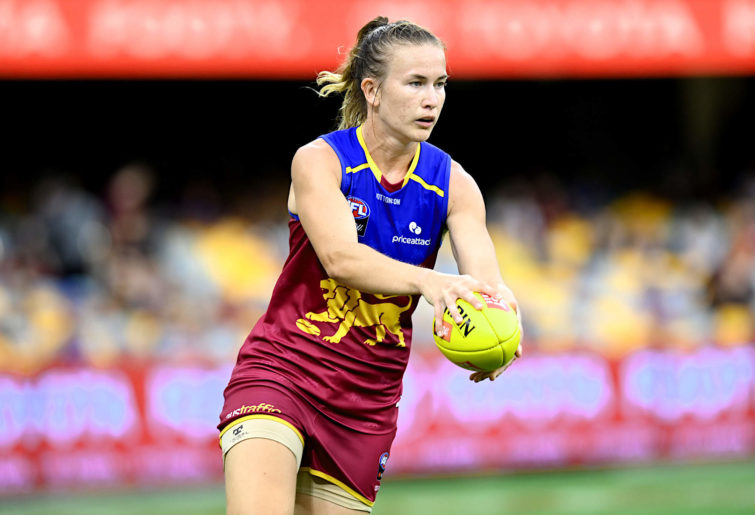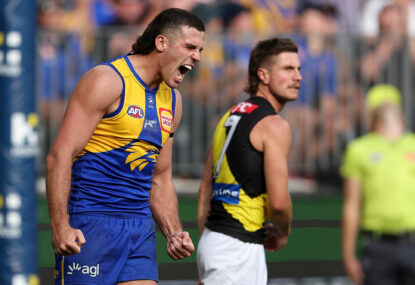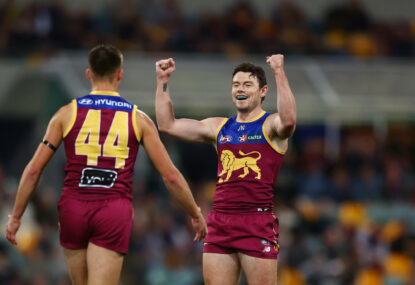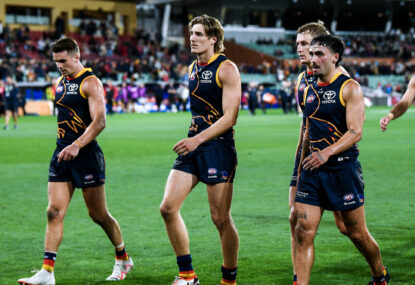I have been a vocal advocate for the AFLW since its inception – long before the opening sell-out and lock-out between Carlton and Collingwood at Ikon Park on February 3, 2017, back to when all-star teams representing Melbourne and the Bulldogs were plying their wares before men’s games in the mid-2010s, selling the public and the patrons on the viability of a national women’s league on the level of the century-old men’s competition.
I’ve often written of the need to appreciate the sport on its own terms – not in contrast to the men’s version, but on its own merits, as a more tactical game that requires different strategies and different skill sets.
Its first season survived mostly on the enthusiasm developed in advance, while many of the games suffered from rugby-like scrums as the teams searched for the formula to win this type of match. Adelaide’s title win was of the style of the season: having the uber-athletic Erin Phillips on their side was much of the difference.
Over the next two years, first as the 2018 champion Dogs began to run and then in 2019 as Adelaide, Fremantle, and the new Kangaroos team took that baton and brought the speed and outside skill that made this version of Australia’s game start to sizzle.
When the Crows routed its two finals opponents that year, the template was set. The growth continued during last year’s pandemic-shortened season, and this season finally saw six to eight teams with the skill, speed, and coaching to create an exciting, appealing, winning form of the game.

Erin Phillips (Photo by Mark Brake/Getty Images)
And Saturday afternoon was its pinnacle.
If you haven’t seen the Brisbane–Adelaide AFLW grand final match, find it online somewhere, and give yourself the two hours necessary to watch the entire game, not just the highlights!
Every moment of that match exuded excellence from both sides of the field. Every single contest was a desperate attempt to win an individual battle against an equally talented opponent. Pick any player on the field, watch them for any length of time, and admire not just the work rate but the skill level employed.
And if you find yourself missing the 70-metre bombs and the leaping marks on the shoulders of the opponent, then stop and appreciate the tools in use in this brand of the greatest game.
I imagine it isn’t dissimilar to an earlier version of the men’s game, before the full-time male athletes brought leg strength to the game that, frankly, the women will simply never possess en masse. That doesn’t make it more or less worthy of appreciation.
It might be akin to what the men’s game might be like today with the larger field it was once played on (did you know early versions of the game had fields that were sometimes twice the length and breadth of the cricket oval?), when it took more than two kicks to span the gap from arc to arc.

(Chris Hyde/AFL Media/Getty Images)
This championship game had everything a footy fan could ask for – intense pressure in both directions, tremendous goal kicking, remarkable contested marks, a surge on Brisbane’s part in the third and the inevitable counter-surge to start the fourth by Adelaide, and most of all, the unbelievably resilient defence of the Lions’ back line, seemingly impervious to every Crows attack.
It was entirely appropriate for Brisbane defender Kate Lutkins to be named player of the match.
You want athletic talent? Watch the goal pulled off by Brisbane’s Courtney Hodder in the second quarter that put the Lions up to stay. Watch the stunning goal by Adelaide’s Stevie-Lee Thompson towards the end of the first.
And watch the last-ditch effort in the third that turned a sure Crows major into a rushed behind that began the title push for Brisbane.
You want heartache?
Both teams’ captains went down with leg injuries within mere minutes of each other in the third quarter, with the game still well in the balance as the Lions held a slim lead at the time (they made them both go up the stairs to say a few words after the game, too, which seems needlessly cruel).
Technically, Adelaide lost its substitute captain, as their original captain went down with a concussion in the prelim final last week and couldn’t do anything except watch her team fall short in the end this time.
You want perseverance?
Eight Brisbane players have fought through five years for this moment. Shannon Campbell didn’t have an avenue to play footy as a young adult so she played collegiate soccer in the US before the opportunity came along.

Shannon Campbell in action (Photo by Bradley Kanaris/Getty Images)
Ally Anderson had lost nine grand finals across all levels of footy across the nation before finally winning number ten on Saturday. And Jessica Wuetschner had just about given up the sport entirely last summer when she was struck by freakin’ lightning and had to fight through a lengthy recovery just to get back on the field.
And after five years, you want competitiveness?
The talent level in Australia has risen, not in small part to the very presence of the AFLW on the field and on the television and the internet, and that rise has spurred the transformation of the league into a viable entertainment of its own volition.
No women’s league in the world, to my knowledge, has yet made a successful run without first being an appendage of a successful men’s league – the role model on this being the National Basketball Association in the US and its 24-year-old distaff version, the WNBA.
Sure, that league relied on its predecessor to stay financially afloat as it sought its sea legs, just as the AFLW must do for now. But today, three of the WNBA’s twelve teams play in a city without an NBA franchise (Seattle, Las Vegas, and Uncasville, a city in southeastern Connecticut situated between Hartford and Boston).
Will there someday be an AFLW team in Tasmania without a men’s club yet in place there? Will the interest in the Northern Territory garner a women’s team in Darwin or Alice Springs?
Or will every club remain planted in its home at Metricon, at Punt Road, at Fremantle?
And in the end, does it matter one way or the other for the health of the league?
Probably not.
The AFLW just needs the same cogent management as the AFL does; it needs the ear to the ground that the men’s league does, to understand what the winds of change dictate in the best interest of the league and the sport as a whole; and it needs the devotion of those of us who appreciate both brands of the game.
About 23,000 fans paid to attend this grand final; coincidentally, it also took the original VFL five seasons to reach that number of fans at its grand final in 1901 (no word whether those were paying customers back then).
But today, there are structures in place for the growth that is to come. And there’s a brand of the game that merits continued growth.
If you aren’t yet on board, watch this grand final. There’s going to be room for everybody.





































































































